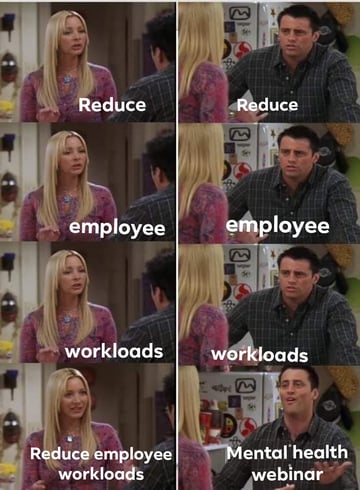- Jun 9, 2021
-
3 min read
3 Factors to Consider When Implementing An Employee Mental Wellbeing Program
In a fast-paced city like Singapore which ranked second-most overworked city in the world just last year, is employee wellbeing being discussed and tended to enough?
According to a 2017 report by Willis Towers Watson, a leading global advisory company, 3 in 5 employees reported ‘average to high levels of stress*’. Two years later in 2019, the Cigna 360 Well-Being Survey revealed that an astounding 92% of working adults in Singapore were feeling stressed* - that’s 8 percentage points higher than the global average of 84%.

Source: Pexels
While stress might be borne by the employee, the impacts of stress - not entirely so. Burnout, stress and low morale are some of the main causes of absenteeism* in the workplace. According to workforce solution company Circadian, unscheduled absenteeism costs roughly $3,600 per year for each hourly worker and $2,650 each year for salaried employees*. In fact, organisations in the Asia Pacific lose an average of 67.5 days of work* time per employee per year due to absenteeism
We can see that the organization’s interest in productivity and employees’ well-being are not opposing forces but are sick leaves really a solution to workplace stress? How does one start taking charge of their own well-being if the work environment guiltify a dedicated employee to even consider a day off?

Source: Pexels
These challenges have been present in the background for years and if anything, the COVID-19 pandemic has only brought it to center stage.
Unsurprisingly, 60% of employers and 70% of employees reported feeling stressed within the past six months (end 2020-early 2021).Of the five countries surveyed, Singapore had the smallest proportion* of those who felt that their employers were supportive of their mental health.
In light of the rising pressure, there is an urgent need for emphasis on mental wellness programs for employees. However, employers that implement wellbeing programs for their employees are in the minority, and only a-third of employees believe they are beneficial.
There are 3 main factors for employers to consider when implementing an employee wellbeing program:
1. Personalization and putting the employee at the center of the experience
We should keep in mind that while a population might have shared experiences of dread and desolation among others, every individual’s mental health experience is unique. Dr Deka, a Regional Consultant for Benefits and Wellness Advisory, noted the importance of customising benefits of programs to each business*.
ThoughtFullChat is designed from the ground up to provide a discreet, high-touch and personalized mental wellbeing coaching experience where our algorithm provides an instant matching to the top 3 best-fit mental health coaches (licensed counsellors, clinical psychologists or licensed psychologists) for a 1-on-1, daily asynchronous text-based coaching. With more than half of the surveyed Singapore employees indicating that they were uncomfortable discussing mental health in the workplace, this private space for ThoughtFullChats would be all the more appreciated and effective.
For employees that require further support and interventions, our mental health coaches are equipped to provide talk therapy in situations where text-based coaching is not suitable.
2. Creating a long term behavioural change while leveraging technology

One of the trends we’ve observed while battling COVID-19 is the emergence of ad-hoc or one-off webinars around wellness which would not be sustainable. There were even satirical social media posts from employees speaking to this phenomenon (see above). Programs should be employee-centred and create long term behavioural change while leveraging on technology. And going digital in this COVID-19 climate, is the safest and most effective means.
ThoughtFullChat is designed to create a proactive habit to engage with mental wellbeing sooner rather than later. Through our bite-size learning content and tools, employees that are not ready to connect with a mental wellbeing coach, can access resources at any time and use tools to help them cope with everyday challenges. As we take tracking and outcomes seriously, employees are able to use an Emotional Scale (DASS21), mood and thought journals to build a habit and understand their own mental health. This has proven to be significantly effective in reducing stress and anxiety.

Source: Pexels
3. Creating a psychologically safe environment
We see implementation of a wellbeing program as a cultural and behavioural shift because mental wellbeing is still a subject with stigma. Common challenges that are often cited by employees include concerns about repercussions if they talk about work-related challenges or being seen as “weak” should they seek help. A mature organization would understand that it takes more than just introducing a new service or app to achieve the desired outcomes.
At ThoughtFull, we work closely with the HR team to identify the key issues, stakeholders and channels required to kickstart the cultural shift while designing an effective and integrated program. We target various levels of employees so that we are ableto craft messaging to outperform the conventional wellbeing program engagement and be able to reach out to employees that would otherwise not have engaged with a mental wellbeing program.
If you would like to learn more about ThoughtFullChat and how we can design an employee wellbeing program that best fits your organisation. Schedule a demo with us today!
Read other Employee Wellness Resources:
- The Future of Employee Wellness Programs: Trends, Impact, and Policies
- 3 Factors to Consider When Implementing An Employee Mental Wellbeing Program
Reference Links:
-
Forbes Article about The Causes And Costs Of Absenteeism In The Workplace
-
Research about Shift Work & Absenteeism
-
AIA Vitality Research About The Healthiest Workplace
-
Survey about Employee Stress Caused By The Covid-19 Pandemic
-
Willis Towers Watson about Health and well-being programs in the Singapore Workforce
Article found on: hrtech.sg

